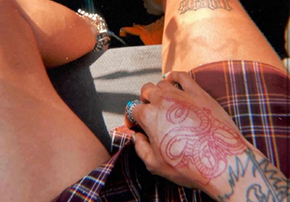Posted by YoniDa'Punani on 5th Oct 2022
The 4 Types Of Material We Offer
Wearing jewelry can be a women's favorite hobby. It is a symbol of femininity and elegance. It gives women confidence and accentuates their beauty.
While wearing jewelry, how often does a question arise in your mind about which type of material is used to make the jewelry? We will tell you that every product is made of different materials.
Here we will discuss the materials used in jewelry making and the pros and cons of using them in your designs. Different kinds of materials are used in jewelry making.
Let's get started.
Stainless steel
Stainless steel is an alloy of iron that is called inox. Stainless steel is rust-resistant and durable. It is very flexible and attractive. It is long-lasting and eco-friendly and can be recycled.
Pros
Stainless steel jewelry is very popular. It is cost-effective and durable. This jewelry is sometimes plated with 14K or 18K gold for different occasions. Stainless steel jewelry is strong and resistant to chemicals and water. This is why it’s so popular amongst jewelry wearers. There are four different grades of stainless-steel jewelry.
● 204 stainless steel
● 304 stainless steel
● 316 stainless steel
● 316L stainless steel
Among these steels, 304 and 316L are commonly used in jewelry production.
306L stainless steel has 20% chromium and 11% nickel. 304 steel contains 19% chromium and 10% nickel. Nickle in stainless steel can cause allergic reactions to the skin. It is sometimes unsafe for people with skin allergies or sensitive to Nickel and other metals.
316L Stainless steel
316 L stainless steel is called surgical steel. It is the best jewelry material. There are many kinds of steel material, but a few are body-friendly; 316 L and 316LVM are body-friendly steel grades.
These properties of stainless steel make this metal a perfect choice for using it in jewelry. Here are a few pros and cons of stainless-steel jewelry
Pros:
It is a durable metal. You can wear it daily. You can wear this metal without worrying about the damage to rings, necklaces, etc. The jewelry made from stainless steel is very affordable in price and durable as well.
It is resistant to abrasions, corrosions, and scratches and is a long-lasting material for jewelry. Stainless steel jewelry is available in many shapes, sizes, and designs. It is very easy to clean stainless steel jewelry. It needs simple care. Just wash it with simple soap and warm water.
Cons:
It is susceptible to developing dents and scratches if used carelessly. It is a rigid material, so you cannot get any intricate styles as you get with silver and gold. Stainless steel can cause allergic reactions as many people are allergic to Nickel (if mixed with it)
Stainless steel jewelry has acrylic, so do not use alcohol. If your jewelry has a gemstone, then do not wash it with alcohol. It will eat all the glue that holds it together. Stainless steel looks like silver and is affordable, so it may not be a bad choice.
PVD-coated steel or titanium:
Pros:
PVD coating is a process used to black coat jewelry. It is called physical vapor deposition. It is an outer coating of base metal titanium and steel. Sterilization treatments with steam and autoclaving are fine for this jewelry. You can easily clean PVD-coated steel or titanium jewelry with antibacterial soap and warm water.
Cons:
PVD-coated jewelry can fade and chip over time. If PVD-coated jewelry is used for oral piercing, it might fade. It depends on the person and saliva, which affects coating differently. Do not use alcohol or hard chemical to clean this type of jewelry.
Titanium:
If you are allergic to steel, then you use titanium jewelry. It is preferred for initial piercings as it is Nickel free. Titanium alloys are graded as 5, 7, 11, 12, and 23. We offer G23 (6AL4V ELI F-136) titanium. Here are some pros and cons of titanium.
Pros:
It is a very strong metal. It is very shiny and glossy. It is rust resistant. It is Nickel free. This metal has low density. It is strong as steel and light as aluminum. It does not get tarnished and corrode or react with sunlight or sweat. This is a perfect type of metal for sensitive types of skin. It is present in a variety of colors. It needs less care. You can wash your jewelry simply with antibacterial soap and warm water.
Cons
It is a bit costly. But it is less costly than gold. It has colored titanium fade over time. It cannot be repaired or soldered. Titanium rings do not have a prong setting as traditional engagement rings have. Titanium has a matte finish, so it is not very glossy as those made of gold or platinum. Do not use alcohol to wash your titanium jewelry.
Brass:
Brass is an alloy of two metals, copper and zinc. It has a golden tone and resembles gold. It is affordable and the material of choice for the jewelry industry.
Pros
Brass jewelry is less valuable than silver and gold. It is perfect for trendy jewelry. It is easily available everywhere. This ubiquitous metal is part of almost every woman's jewelry fashion collection. Even men use this metal. You'll find them rocking a brass ring or bar cuff on a casual day. Nowadays, it is extremely popular in the fashion world for homemade and customized jewelry. It is durable and rust-resistant. It needs low maintenance. Pure brass is one of the safest jewelry
Cons:
Brass is a metal prone to tarnish. With time it loses its shine and develops a greenish layer. This greenish layer is due to the oxidation of copper in brass. To prevent tarnishing to brass jewelry, all brass and copper must be removed before showering and washing your face. But all other materials you may wear in the shower or washing your face. This metal can cause an allergic reaction, so people with sensitive skin may experience some itchiness and rashes from wearing brass jewelry.
Sterling silver is Nickel, and lead-free
Silver is the 3rd most Nobel metal after gold and platinum. It is inexpensive than gold and silver. It is a very soft metal, so suppliers do not use 100% pure silver to make jewelry. So a little mixing of some alloys is done to improve its shine and durability.
Pros
Sterling silver metal contains 7.5 % of copper and 92.5 % of silver. That is why it is called 925 sterling metal. 925 silver is a good choice for fashion jewelry as it looks high-grade. All of our sterling silver is coated in 22k, which won't turn the nose and won't turn it green or leave a mark, it is nickel-free, lead-free, and not harmful to the body.
Cons
The downside of sterling silver is that it is very soft and may scratch and bend in daily wear. Jewelry made of sterling silver will eventually tarnish. To maintain its shine, you should clean it regularly. Sterling silver with gold doesn't tarnish. It may rust over time, 2+ years. We provide tarnish tabs for each order; we try to help prolong the tarnish but use it on already tarnished pieces.
Copper charms are Nickel and lead-free
Pure copper metal is not so hard, so it is mixed with tin and zinc to strengthen it. As an alloy, it is extremely durable. So, it is a good choice for jewelry making.
Pros
Copper metal is extremely durable, and its jewelry lasts longer despite wearing it daily. Its jewelry is very beneficial for human health. It is an orange-red hue in color. It is antimicrobial and antifungal. It is safe for our skin. Copper jewelry is highly adaptable, and you can design it in different shapes. Copper alloys like brass and bronze are popular in the market. Copper charms are Nickel and lead-free.
Cons
Copper is a metal that is very much prone to tarnish. It will get a green layer over time. This green coating is due to the oxidation of the copper. It is very soft and can easily get scratches and breaks faster than costly metals. With a little care it can last a long time. All brass and copper jewelry must be taken out before showering and washing your face.
Gold
Gold is the 2nd most Nobel metal after platinum. It can be extremely expensive. It is very soft, adaptable, and used to create intricate designs and shapes.
Pros
About 50% of the gold is used in jewelry products. Pure gold is very shiny and soft. It is extremely adaptable and pliable. Due to its softness, pure gold jewelry is very prone to scratches and can lose its shape. Different alloys are added to change its hardness when combined with different alloys. A gold alloy is often used in the market and is named K gold. Pure gold is 24K and is very soft.
● 22 K gold
● 18 K gold
● 14 K gold
● 10 K gold
Most industry gold products are 18K gold or 14k gold as it saves cost and provides durability to jewelry.
24 K Gold:
24k gold is purest and very soft and malleable. It is not possible to make pure gold jewelry as due to its softness, it can bend and get scratched easily. So, it is impractical to make a piece of jewelry for daily wear as it will lose its shape. We do have products in gold vermeil; for example, the butterfly nose stud is 24k.
22 K Gold:
22k gold is 92% gold and 8% alloys; the small mixture of alloys makes it durable and last longer than pure gold, but it needs care as it is soft, can bend, and get scratched easily. Most jewelry is 18k or 22k, 24k.
18K Gold:
18K gold is 75% of gold and 25% of alloyed metals. It contains 5% silver, 20% copper, and 75% of gold. The traditional mix of gold and most jewelry is 18k gold. It has a deeper yellow tone than 14K gold as having a higher gold percentage. It is much more stable than 22k gold. It is perfect gold in hardness and provides a good gold luster after polishing.
14K Gold:
14k gold is 58% pure gold and 42 % alloyed. It contains other alloys like copper and zinc nickel. It is durable and has the same properties as 18K gold but is cheaper than 18K. It saves on cost. We do not offer 14k solid gold. Some of our products use 14k gold, but we use protection oil to last a little longer. We offer some sterling silver with gold vermeil. It is the most popular choice in the market, especially in the US.
10K Gold
Is the cheapest form of gold and contains 41% pure gold and 59% alloyed metals. It is light yellow in the shade and durable and cost-effective. 10k gold isn’t used very often.
Pure gold doesn't get tarnished, but gold in different K gets tarnished due to the mixing of alloys. Check out our other blog on tips to clean your jewelry.
We all know that jewelry is the main part of our accessories that we use to look more stylish, beautiful, and attractive. We got you if you're looking for a confidence booster in pictures and a date night out. If you want a quick look but still feel like the baddie. Then we offer many kinds of jewelry and materials and can help you select the jewelry that suits you and your pocket.
Final Thoughts
Knowing that pros and cons of different jewelry and what it’s made of can really help you decide which jewelry really suits your needs.





